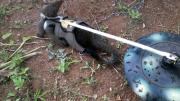Standing outside a Sri Lankan army base in the spring of 2007, Thrishantha Nanayakkara mapped an entire minefield without once setting foot in it. Nanayakkara held a remote control and periodically made a note on his computer. A mongoose hitched to a robot did most of the work.

Courtesy of Thrishantha Nanayakkara
Two linked robots directly behind the sensor allow a human operator to direct the mongoose over the minefield without risk of personal injury. The robots move by flexing their jointed bodies back and forth.
Nanayakkara, a visiting scholar at the School of Engineering and Applied Sciences and a 2008-09 Radcliffe Institute fellow, picked an indigenous mongoose for its temperament, size (roughly 2.5 kilograms, light enough to step on a mine without detonating it), and sense of smell (able to detect explosives three meters away). He equipped his robot (roughly a meter long and half a meter wide) with a harness to keep the mongoose under control and a video camera to record its findings. Although the mongoose walks a few feet ahead, the robot with its eight metal legs sets the pace. During the test run, the pair went back and forth across a 10-by-10-meter plot, stopping whenever the mongoose detected a mine, which it indicated by sitting up (as it was trained to do). In a morning’s work, the mongoose found every mine.
The land mines in Sri Lanka—and other war-torn nations—are both physical obstacles and obstacles to economic growth. “To understand how de-mining expands economic activity, it is good to imagine the reverse,” Nanayakkara says. “Let’s say there are five land mines in Boston, and we don’t know where they are. Immediately people restrict their movements to the most essential errands. This worsens if we get the news that somebody has been caught in a mine blast. The remaining four land mines can freeze the economic activity of Boston.” In Sri Lanka, the land mines laid by both the government and Tamil Tiger rebels number between 1.5 million and 3 million.
Although Nanayakkara no longer works directly with Sri Lankan military engineers, he is perfecting at Harvard what he once demonstrated in practice. Developed with a team of students at the University of Moratuwa, the robot’s characteristics (such as size, speed, and sensing ability) have now been programmed into a minefield simulation that includes obstacles like trees or rough terrain. By digitally tweaking the robot’s design, Nanayakkara can determine how various mechanical changes improve its efficiency.
Perfecting the machine’s locomotion, he believes, is the first step. He is working with students and professors at Harvard and MIT to develop a spring-loaded leg to help the robot move more easily over the soft dirt of the jungle floor.
He trained his three mongooses mostly through trial and error: rewarding them for reacting to explosives held on a stick, then covering the cage so that they would learn to identify their target by scent, rather than sight. At Harvard, he is taking a more systematic approach by collaborating with assistant professor of molecular and cellular biology Naoshige Uchida, who is studying how rats learn to pick out a single smell in a pungent environment. Nanayakkara hopes that determining how another rodent’s brain sorts smells will lead to improved training techniques that in turn will make his country a safer place to live.
“Land mines write off fertile farmlands and destroy social structures,” he says. “Efficient removal of mines helps the affected communities to return to a normal, productive life.”









